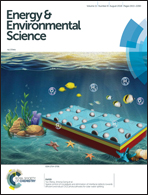Highly efficient hydrogen evolution triggered by a multi-interfacial Ni/WC hybrid electrocatalyst†
Abstract
Exploring high-performance electrocatalysts for sustainable hydrogen production is an essential prerequisite of a further hydrogen economy. Integrating multiple interfaces in two-component electrocatalysts is expected to be a feasible strategy to optimize the intrinsic electronic structure of hybrid catalysts and improve their catalytic property. Herein, we report a new type of multi-interfacial nickel/tungsten carbide (Ni/WC) hybrid nanoparticles anchored on N-doped carbon sheets (Ni/WC@NC), which can efficiently and robustly catalyze the hydrogen evolution reaction (HER) with striking kinetic metrics in a wide pH range. In 0.5 M H2SO4, Ni/WC@NC displays a low overpotential (53 mV at current density of 10 mA cm−2), a small Tafel slope (43.5 mV dec−1), a high exchange current density (0.83 mA cm−2), as well as excellent stability, outperforming most of the current noble-metal-free electrocatalysts. A series of controlled experiments, DFT calculations and in situ XAS measurements reveal that the remarkable HER activity is mainly attributed to abundant interfaces between Ni and WC domains, which induce a synergistic optimization of the electronic configuration of Ni and WC through electron transfer process from WC to Ni along with potential mass transport, thus promoting the HER kinetics and accelerating the reaction. Our work suggests a potentially powerful interface-engineering strategy for designing high-performance electrocatalysts for the HER.



 Please wait while we load your content...
Please wait while we load your content...